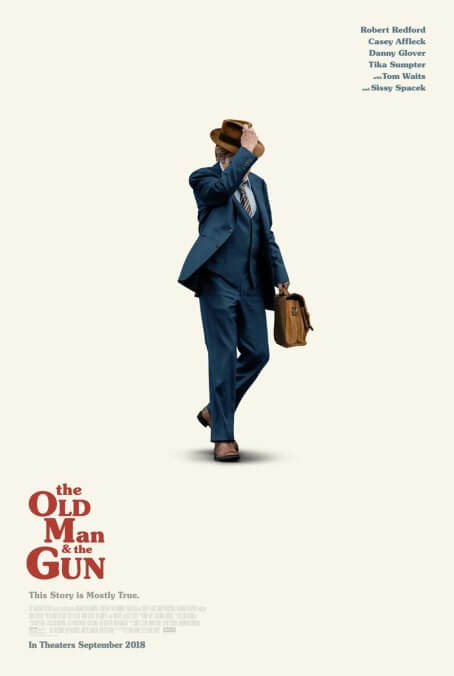Although the character often comes across as some sunset-years amalgam of the Sundance Kid, Johnny Hooker, and every other desperado Redford brought to swaggering life during his New Hollywood heyday, the source of inspiration is a real career criminal. His name was Forrest Tucker, and he got famous for a lifetime of breaking the law and spectacularly breaking out. (He’s said to have escaped from prison at least 16 times, and to have mounted maybe a dozen more unsuccessful attempts.) Tucker’s life story practically begs for the sprawling biopic treatment. But Lowery, the ’70s-movie nut who made the Pete’s Dragon remake and last year’s bewitching existential whatsit A Ghost Story, has something else in mind: a supremely laid-back outlaw saga that doubles as a wistful celebration of another era of movies, movie stars, and American life.
Lowery’s counterintuitive approach begins with the way he almost completely ignores the most sensational aspect of Tucker’s story: his frequent, remarkable escapes, which get relegated to a (admittedly pretty amazing) montage. Instead, the writer-director’s screenplay, which takes loose inspiration from a New Yorker article, is set in the early 1980s, when a sixtysomething Tucker—fresh off one of his last flights from the big house—knocked off a string of banks. (His accomplices, played here by Danny Glover and Tom Waits, were also elderly, leading the press to dub them The Over The Hill Gang.) After one of the robberies happens almost literally under his nose, a rumpled detective, John Hurt (Casey Affleck), begins seriously working the case. It’s in keeping with the gentle spirit of the material that he seems at most annoyed, and often even faintly amused, by Tucker’s cross-state crime spree. Maybe it’s that everyone, even those the man holds up at gunpoint, seems to regard him as a gentleman. Or maybe it’s a kind of begrudging respect, from one professional to another. The lawman’s adorable daughter astutely posits another theory: “If you caught him, you wouldn’t get to chase him anymore.”
The Old Man & The Gun downplays violence and danger at every turn; tellingly, the one moment where someone actually gets hurt happens entirely off-screen. Lowery is more invested in Tucker’s budding romance with Jewel (Sissy Spacek, a screen legend in her own right), the widow he stops to flirt with during the opening getaway, risking capture to provide some roadside assistance. The pair’s scenes together practically glow with a sexy, easygoing chemistry; their first date, at a diner later that afternoon, is exquisitely written and performed—the meet-cute as a duet of wits and mutual attraction. There’s a relaxed and almost Soderberghian finesse to how Lowery stages these moments of late-in-life courtship, down to the way he stylishly jumbles some of the conversations. Who is Tucker, really, but a much older version of the charismatic criminal George Clooney played in Out Of Sight, still knocking off banks with a smile several decades later?
The director’s style, looser than it was in the austerely hushed and stationary A Ghost Story, goes heavy on borrowed, throwback affectation: a slow zoom here, a Paul Simon song there, the grainy splendor of Joe Anderson’s imitation Néstor Almendros lensing. Lowery’s most reliable 1970s accessory is, of course, Redford himself, who’s reached the point in his career—familiar only to performers of a certain age and legacy—when just his appearance alone brings a whole bygone age of moviemaking (and movie magic) rushing back. Lowery leaned heavily on Redford’s iconic quality, his weathered cowboy familiarity, in Pete’s Dragon. Here he never misses an opportunity to foreground it: by sitting the actor on a horse, by plopping him down into a movie house, by literally placing an old photo of him side-by-side with a new one, confronting the audience with what time does even to our marquee and matinee idols. (In another trick filched from Soderbergh, he also repurposes ancient footage of the actor for a flashback—talk about a ghost story!) But while just arranging Redford in the frame is going to trigger plenty of emotions, the star brings more than the vestiges of a famous career to the table this time. He’s charming and magnetic in a way he hasn’t been in ages, while also locating the sadness in an outlaw whose compulsive need to transgress is confronted, for perhaps the first time ever, with something he might stand losing.
“You hear a story, you see a picture, you put two and two together,” one of the detective’s interview subjects says. She’s talking about how people confuse others’ reflections for their own, mixing up anecdotes with memories. But the words could also describe the relationships audiences forge with movie stars like Redford, and the way a character can emerge from a combination of the details a film provides and the association we have to the person playing them. The Old Man & The Gun is so reliant on the echoes of past films, on the career it’s constantly evoking and riffing on, that it sometimes feels as ephemeral as dust floating in a projector beam. But there’s something truthful and even moving in the way Lowery conflates the joy of one impossible occupation with that of another. Tucker can’t help himself—he has to keep robbing banks, long past the point when any sensible crook would hang up his pistols. Given how the actor playing him has just staved off retirement again, there’s a glimmer of confession in his unbroken smile: We really are just seeing Redford up there on-screen, maybe more clearly than we ever have before.

